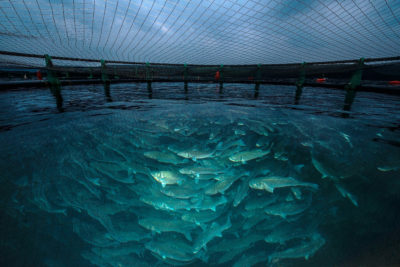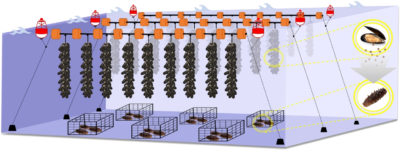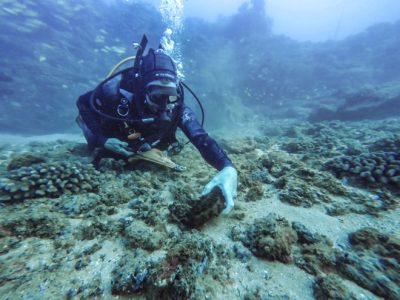Off the coast of the Hawaiian Island of Kauai, an underwater metropolis bustles. Sea turtles glide lazily through the surf while schools of fluorescent yellow butterflyfish weave between basketball-size sea urchins and sharp corals.
But Dave Anderson isn’t distracted by the otherworldly charm of the coral reef — he’s here on a mission. Around 70 feet below the surface, he finds his prize: a red sea cucumber.
Anderson plucks the spiky creature from the sea floor and, after a brief boat ride, delivers it to a glistening 18-acre pond at the Kauai Sea Farm, on the island’s southwest coast. Anderson is the production manager of this small commercial operation, which raises mullet, barracuda, tilapia, and other seafood for sale to local restaurants. But the sea cucumber in Anderson’s hands isn’t for eating — at least, not yet. Instead, this bottom-dwelling echinoderm is the newest member of the fish farm’s cleaning crew.
In the wild, sea cucumbers roam the sea floor, hoovering up sand and digesting the fish waste, algae, and other organic matter it contains. Sand they excrete is cleaner than sand they consume, which is why sea cucumbers are often called “the true vacuums of the sea floor,” says Arnold Rakaj, a marine biologist at the University of Rome.
Now, Anderson is letting these slimy organisms perform the same service at Kauai Sea Farm.
On seafood farms, fish waste can build up to harmful levels, fueling disease outbreaks that kill millions of fish each year.
Aquaculture, or fish farming, now supplies more than half of the seafood consumed by humans globally, and the industry is projected to continue increasing to help feed growing populations. However, land-based and offshore fish farms face a big problem. With hundreds and sometimes thousands of fish swimming in the same net, pond, or tank, uneaten food, fish waste, and the bacteria it contains can build up to harmful levels, fueling outbreaks of bacterial diseases — such as fin rot, mycobacteriosis, and bacterial gill disease — that kill millions of farmed fish each year.
The uneaten feed and waste contain nutrients like phosphorous and nitrogen that can accumulate and sink to the bottom, where they can fuel algal blooms or feed bacteria that suck oxygen from the water, creating “hypoxic” conditions that suffocate captive fish and kill native organisms that surround offshore farms. Recirculating systems that filter water and remove waste can be installed, but these structures require a lot of energy and maintenance, and they can cost upward of $200,000 on a large commercial aquaculture farm.
Sea bass at a fish farm in the Adriatic Sea off the coast of Slovenia.
WaterFrame / Alamy Stock Photo
As an alternative, fish farms can culture sea cucumbers along with their finfish and shellfish to improve water quality and increase overall productivity, a wide body of research suggests. Now, a modest but growing number of seafood farmers across Europe, North America, and elsewhere are raising sea cucumbers to act as living Roombas in tanks, cages, and ponds. Once aquaculturists build up enough stock, they can sell a portion of their sea cucumbers for human consumption, providing another source of revenue for their farms. Such efforts, say experts, could help reduce demand for wild sea cucumbers, which are being fished to the point of extinction in some places, including in India and in Mexico.
These initiatives are part of a broader movement — called “Integrated Multi-Trophic Aquaculture” (IMTA) — to redesign fish farms so they work more like biologically diverse natural ecosystems than like highly polluting monocultures. Instead of raising just one marine species, like salmon or tilapia, farmers practicing IMTA reduce waste by cultivating multiple species from different levels of the food chain — from sea cucumbers to mussels to kelp.
“You’re trying to mimic a natural environment,” says Chris Pearce, a marine researcher from Canada’s Department of Fisheries and Oceans. “So marine species are just doing what they do naturally out in the wild. But when you combine them with other species, what they’re doing is creating a service for the ecosystem.”
“What is waste for somebody is gold for somebody else,” one scientist says of sea cucumbers feasting on fish feces.
Though fish farmers in China have been raising fish alongside other species, like kelp and clams, for centuries, the practice was formally introduced in Western nations just 20 years ago, when marine scientist and aquaculture consultant Thierry Chopin first coined the term Integrated Multi-Trophic Aquaculture. “What is waste for somebody is gold for somebody else,” says Chopin, referring to the sea cucumbers feasting on fish feces. The concept has gained attention in the past few years as fish farmers seek ways to minimize their environmental impact while diversifying their sales.
Sea cucumbers may not look particularly appetizing to everyone, but they are considered a delicacy in China and Japan. They can be prepared raw, like sashimi, fried or, most often, dried then rehydrated in soups and stews. More than 1,250 species of sea cucumbers live in oceans from the tropics to the poles, and most sell for around $3 per pound, though some particularly rare species can go for as much as $1,400 per pound, dried.
“Economic sustainability is [often] overlooked when we talk about sustainable aquaculture,” Kauai Sea Farm’s Anderson says. “If you build this whole farm, and it’s not economically sustainable and then it just crashes … that’s a huge environmental impact and nothing came out of it.”
Diagram of a test project in Italy in which sea cucumbers cleaned up excrement from farmed mussels.
Grosso et al.
But there are still hurdles to scaling up. For one, getting a permit to raise more than one species on a farm is an extremely arduous process in North America and Europe, fish farmers say. And even if they are able to get a permit, says Halley Froehlich, an aquaculture researcher at the University of California, Santa Barbara, “it’s really hard to grow multiple species in a natural way, all at once.” Fish may not grow as fast as expected, or they may die for unknown reasons.
Kauai Sea Farm started rearing native Hawaiian sea cucumbers last year, with the help of a nearly $300,000 grant from the National Oceanic and Atmospheric Administration. For the project, which operates with a research permit, 12 sea cucumbers were pulled from the wild and introduced to the pond to see if they could survive in this setting. But the pond will need many more cucumbers to improve its water quality, so Anderson is working with scientists at the University of Hawaii to develop a program that induces spawning in three different native sea cucumber species as a way to scale up supply in the farm’s new land-based hatchery.
Kauai Sea Farm’s project is still too new to be declared an unqualified success, but it is following the lead of aquaculture operations around the world that are already testing sea cucumbers in their systems. For example, in 2018, researchers from the University of Stirling, in Scotland, studied how sea cucumbers grew under a cage of sea bream at Malta Fish Farming, an offshore operation in the Mediterranean Sea. They quickly learned that where they put the sea cucumbers was critical; those placed directly under the fish were literally smothered to death by feces, says Karl Cutajar, the study’s lead author. But when the researchers put them beyond the shadow of the sea bream cage, the sea cucumbers grew much faster than they do in the wild, an indication that they were thriving on the waste.
“To be able to switch species and have flexible farming practices is almost impossible” because of bureaucracy, says a researcher.
A number of similar experiments performed with sea cucumbers and other species — such as mussels in Italy, seabass in Scotland, and shrimp in Kenya — have also shown improved productivity and water quality on fish farms. Recently, researchers from Canada’s Department of Fisheries and Oceans used sea cucumbers to remove the algae and muck that weigh down nets at Creative Salmon, an organic fish farm in British Columbia. Though their results have not yet been published, marine biologist Emaline Montgomery says they did see “proof of concept”: the sea cucumbers were hoovering up algae and salmon refuse.
“At the beginning, I was a little unsure of how it was going to go,” says Barb Cannon, the biology manager at Creative Salmon. “But I was proven wrong on all fronts, and the sea cucumbers did really well.”
Cannon is still skeptical that IMTA can reach commercial scale on her farm any time soon. To succeed in the long-term, the farm would need its own sea cucumber hatchery so it wouldn’t deplete wild populations. And getting a license for farming sea cucumbers, she says, “can take a significant amount of time.”
Part of the reason for the regulatory logjam is that neither Canada, the United States, nor Europe has just a single entity regulating the aquaculture industry. In the U.S., for example, a total of seven different federal agencies are responsible for regulating aquaculture, and policies focus on raising only one marine species at a time. “So to be able to switch species and have flexible farming practices is almost impossible,” says Froehlich, of the University of California. The bureaucratic hurdles for IMTA are “extraordinary, [considering] how rapidly this industry is changing and how important it’s becoming at a global level for seafood production.”
Back in Hawaii, Kauai Sea Farm operates a bit differently than most North American commercial fish farms. It’s located on the Nomilo Fishpond, which is part of a network of centuries-old Indigenous Hawaiian loko i’a — ponds connected to the ocean by narrow rocky channels. In the traditional fishing technique, baby fish swim into the pond from the ocean through a series of gates and remain inside until they’re too big to swim back out. Unlike many traditional loko i’a, the farm has its own land-based hatchery where nutrient-rich water is pumped in from the pond and passes through a system of tanks containing oysters, clams, sea urchins, and sea cucumbers before circulating back to the source. Every species has its own role to play in maintaining the farm, following both the modern-day concept of IMTA and the loko i’a tradition. As Lynn Taylor, the native Hawaiian owner of Kauai Sea Farm, puts it, “We’re basically the MacGyver of fishponds.”
Still, Kauai Sea Farm is not immune to the problems that other fish farms face when trying to raise more than one species. It hasn’t yet cracked the code of how to reliably control the reproductive cycles of the sea cucumbers. “Let’s say this becomes a commercial thing,” Anderson says. “You can’t just lose a year of production because the animals didn’t cooperate that year.” He adds, “They are very complicated for such a slug-looking creature.”
In recent years, scientists in Sweden, Vietnam, and Sri Lanka have figured out how to successfully spawn other sea cucumber species from their regions, so Anderson hasn’t yet lost hope. In fact, he is trying out another spawning method this month. If the team can keep the sea cucumbers alive to adulthood, Kauai Sea Farm could eventually have both a larger cleaning crew for the pond — and a new seafood product to sell.
Correction, May 26, 2023: An earlier version of this story incorrectly identified the biology manager at Creative Salmon. She is Barb Cannon, not Barb Collins.



